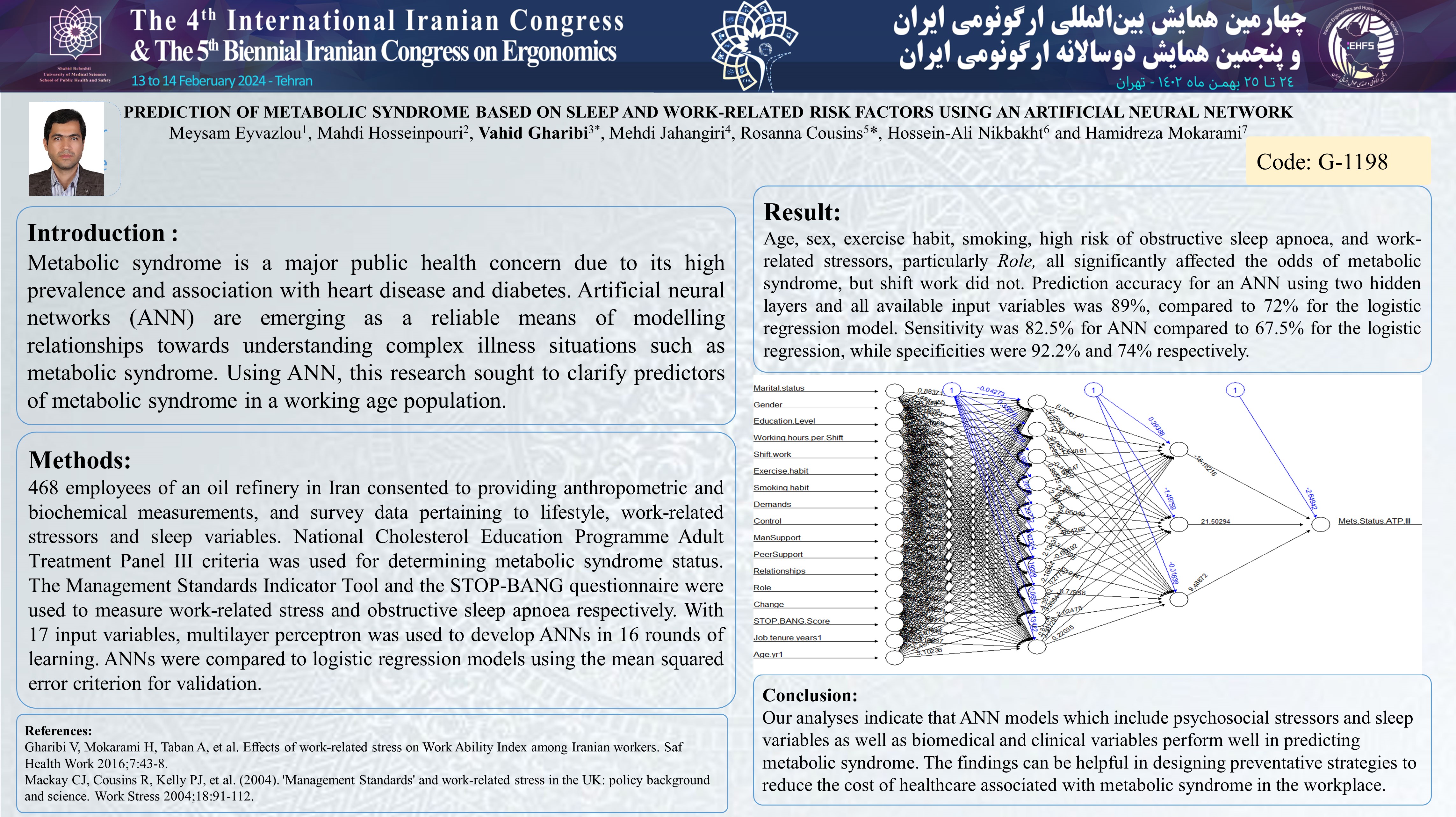PREDICTION OF METABOLIC SYNDROME BASED ON SLEEP AND WORK-RELATED RISK FACTORS USING AN ARTIFICIAL NEURAL NETWORK
Code: G-1198
Authors: Meysam Eyvazlou, Mahdi Hosseinpouri, Vahid Gharibi © ℗, Mehdi Jahangiri, Rosanna Cousins, Hossein-Ali Nikbakht, Hamidreza Mokarami
Schedule: Not Scheduled!
Download: Download Poster
Abstract:
Introduction
Metabolic syndrome is a major public health concern due to its high prevalence and association with heart disease and diabetes. Artificial neural networks (ANN) are emerging as a reliable means of modelling relationships towards understanding complex illness situations such as metabolic syndrome. Following from this, the aim of this study was to assess whether an artificial neural network can be used to accurately predict MetS. The objective was to present an examination of the separate and simultaneous effects of a full range of predictive variables, including sleep and work-related stress variables, as well as clinical variables, to test ANN. In order to achieve an optimal ANN architecture, we considered ANN with different hidden layers and different numbers of neurons in each hidden layer.
Methods and Materials / Case Report
468 employees of an oil refinery in Iran consented to providing anthropometric and biochemical measurements, and survey data pertaining to lifestyle, work-related stressors and sleep variables. National Cholesterol Education Programme Adult Treatment Panel ІІI criteria was used for determining metabolic syndrome status. The Management Standards Indicator Tool and the STOP-BANG questionnaire were used to measure work-related stress and obstructive sleep apnoea respectively. With 17 input variables, multilayer perceptron was used to develop ANNs in 16 rounds of learning. ANNs were compared to logistic regression models using the mean squared error criterion for validation.
Results
Age, sex, exercise habit, smoking, high risk of obstructive sleep apnoea, and work-related stressors, particularly Role, all significantly affected the odds of metabolic syndrome, but shift work did not. Prediction accuracy for an ANN using two hidden layers and all available input variables was 89%, compared to 72% for the logistic regression model. Sensitivity was 82.5% for ANN compared to 67.5% for the logistic regression, while specificities were 92.2% and 74% respectively.
Conclusion
Our performance evaluation of ANN indicated our model was highly efficient at predicting MetS. Following 16 rounds of model learning using 17 input variables and one target variable, we developed a model that had 10 neurons in first hidden layer and 3 neurons in a second hidden layer and was able to predict MetS with 89% accuracy. Based on our findings, preventive public health policies for reducing levels of MetS are necessary. These should focus on modifying lifestyle practices such as quitting smoking, having regular physical activity and an appropriate sleep schedule. There is also a strong case for effective risk assessment of WRS, and intervention where necessary. We also recommend screening opportunities in the workplace to detect early risk factors for MetS. There is a business case for this, as the high prevalence of MetS in working communities can be a major economic and operational burden. We assert that ANN are useful for identifying data patterns and those at risk of MetS, who can then be prioritised in terms of offering tests and interventions saving resources, including health.
Key Words
MetS; work-related stressors; OSA; modelling; health promotion.
Comments (0)
Post a comment
Post comment is closed by admin.
